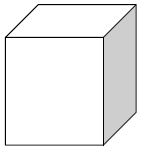
 |
|
|
|
Eulers FormulaEulers formula compares the number of faces, edges, and vertices of a polyhedron.
This formula applies to polyhedron, which are three-dimensional figures comprised of polygons. Take a look at a very basic example below. The figure shown is a cube, which has 6 sides that are all squares.
As it was state previously, this formula applies to all convex polyhedron. The cube is just one example.
Read more about Leonard Euler's contributions to mathematics. Most notably, you can thank (or criticize!) him for the development of function notation.
Return from Eulers Formula to more Free Geometry Help or visit the GradeA homepage for more free math help.
|
| . | ||
| Home │ Site Search │ Math Help Blog │ Help Keep GradeA Free | |
Written by Team GradeAmathhelp.com, all rights reserved. | ||
